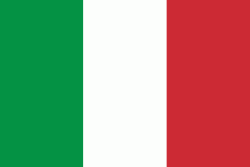Leonardo da Vinci–Fiumicino Airport (Leonardo da Vinci–Fiumicino Airport)
Rome–Fiumicino International Airport "Leonardo da Vinci" (Aeroporto Internazionale di Roma–Fiumicino "Leonardo da Vinci"; ), commonly known as Leonardo da Vinci–Fiumicino Airport, is an international airport in Fiumicino, Italy, serving Rome. It is the busiest airport in the country, the 10th busiest airport in Europe and the world's 49th-busiest airport with over 29.3 million passengers served in 2022. It covers an area of 16 km2.
Together with Ciampino Airport, it forms the Rome airport system with 32.8 million passengers in 2022, the second airport system in Italy by number of passengers.
The airport is an ITA hub and was previously a hub for Alitalia, the defunct flag carrier and at one time Italy's largest airline.
As of 2022, it has won the "Best Airport Award" in the category of hubs with over 40 million passengers, issued by Airports Council International (ACI) Europe, for three years in a row.
Together with Ciampino Airport, it forms the Rome airport system with 32.8 million passengers in 2022, the second airport system in Italy by number of passengers.
The airport is an ITA hub and was previously a hub for Alitalia, the defunct flag carrier and at one time Italy's largest airline.
As of 2022, it has won the "Best Airport Award" in the category of hubs with over 40 million passengers, issued by Airports Council International (ACI) Europe, for three years in a row.
| IATA Code | FCO | ICAO Code | LIRF | FAA Code | |
|---|---|---|---|---|---|
| Telephone | Fax | ||||
| Home page | Hyperlink |
Map - Leonardo da Vinci–Fiumicino Airport (Leonardo da Vinci–Fiumicino Airport)
Map
Country - Italy
 |
 |
| Flag of Italy | |
Italy was the native place of many civilizations such as the Italic peoples and the Etruscans, while due to its central geographic location in Southern Europe and the Mediterranean, the country has also historically been home to myriad peoples and cultures, who immigrated to the peninsula throughout history. The Latins, native of central Italy, formed the Roman Kingdom in the 8th century BC, which eventually became a republic with a government of the Senate and the People. The Roman Republic initially conquered and assimilated its neighbours on the Italian peninsula, eventually expanding and conquering a large part of Europe, North Africa and Western Asia. By the first century BC, the Roman Empire emerged as the dominant power in the Mediterranean Basin and became a leading cultural, political and religious centre, inaugurating the Pax Romana, a period of more than 200 years during which Italy's law, technology, economy, art, and literature developed.
Currency / Language
| ISO | Currency | Symbol | Significant figures |
|---|---|---|---|
| EUR | Euro | € | 2 |
| ISO | Language |
|---|---|
| CA | Catalan language |
| CO | Corsican language |
| FR | French language |
| DE | German language |
| IT | Italian language |
| SC | Sardinian language |
| SL | Slovene language |















